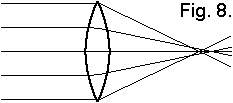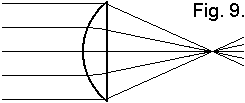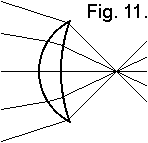Chapter 21
Spherical aberration
One defect that affects correct focusing of lenses is called spherical
aberration. This is caused by a different focus point of the centre part and the
edges of the lens, see fig. 8.

This spherical aberration can be minimised by curving the lens, i.e. moving the
edge in respect to the centre part of the lens. In the case of fig. 8 you might
see that we have to move the edges to the right. We now obtain a lens with one
spherical surface (convex) and one almost flat surface (planar).

The amount of the spherical aberration depends on the way light is entering and
leaving the lens. When light is a parallel beam at one side of the lens, then
the minimal spherical aberration occurs when the other surface is flat.
Between the two lenses of a condenser system, see fig. 4, the beam is parallel
so the condenser system has to be flat on both sides. To be precise, in fig. 4
the left lens should have been drawn less curved, thus thinner than the lens on
the right.

When the beam enters the lens in a diverging way and leaves in a converging way,
both surfaces should be convex. For reasons of symmetry both surfaces must have
the same curvature if object and image have the same distance from the lens,
see fig. 10.

When light enters the lens in a converging way and is even more focused by the
lens, then we need a convex-concave lens. In practice, this is done in the
better photo cameras, to further minimise spherical aberration, by using several
lenses instead of just one.
Spectacles always have convex-concave lenses, so they are not at all optimised
for spherical aberration. It looks as if this is only done to prevent your
lashes touching the glass.
As a general conclusion: lenses should be used in such a way that both glass
surfaces contribute more or less the same amount of focusing action. The bend in
the rays of light should be almost equal on both sides of the lens.



